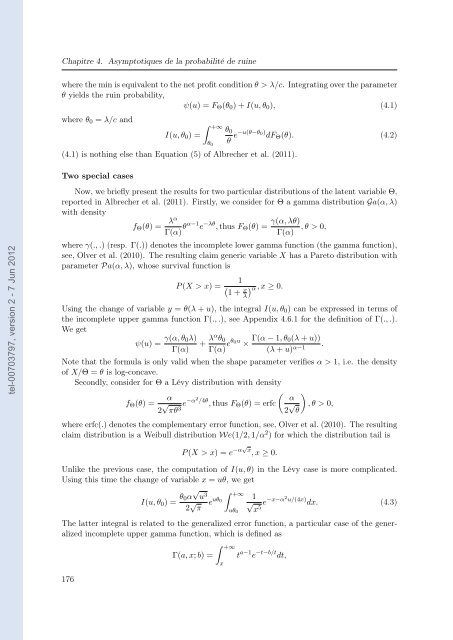Etude des marchés d'assurance non-vie à l'aide d'équilibres de ...
Etude des marchés d'assurance non-vie à l'aide d'équilibres de ...
Etude des marchés d'assurance non-vie à l'aide d'équilibres de ...
Create successful ePaper yourself
Turn your PDF publications into a flip-book with our unique Google optimized e-Paper software.
tel-00703797, version 2 - 7 Jun 2012<br />
Chapitre 4. Asymptotiques <strong>de</strong> la probabilité <strong>de</strong> ruine<br />
where the min is equivalent to the net profit condition θ > λ/c. Integrating over the parameter<br />
θ yields the ruin probability,<br />
ψ(u) = FΘ(θ0) + I(u, θ0), (4.1)<br />
where θ0 = λ/c and<br />
I(u, θ0) =<br />
+∞<br />
(4.1) is nothing else than Equation (5) of Albrecher et al. (2011).<br />
Two special cases<br />
θ0<br />
θ0<br />
θ e−u(θ−θ0) dFΘ(θ). (4.2)<br />
Now, we briefly present the results for two particular distributions of the latent variable Θ,<br />
reported in Albrecher et al. (2011). Firstly, we consi<strong>de</strong>r for Θ a gamma distribution Ga(α, λ)<br />
with <strong>de</strong>nsity<br />
fΘ(θ) = λα<br />
Γ(α) θα−1 e −λθ , thus FΘ(θ) =<br />
γ(α, λθ)<br />
, θ > 0,<br />
Γ(α)<br />
where γ(., .) (resp. Γ(.)) <strong>de</strong>notes the incomplete lower gamma function (the gamma function),<br />
see, Olver et al. (2010). The resulting claim generic variable X has a Pareto distribution with<br />
parameter Pa(α, λ), whose survival function is<br />
1<br />
P (X > x) = <br />
x α , x ≥ 0.<br />
1 + λ<br />
Using the change of variable y = θ(λ + u), the integral I(u, θ0) can be expressed in terms of<br />
the incomplete upper gamma function Γ(., .), see Appendix 4.6.1 for the <strong>de</strong>finition of Γ(., .).<br />
We get<br />
γ(α, θ0λ)<br />
ψ(u) =<br />
Γ(α) + λαθ0 Γ(α) eθ0u Γ(α − 1, θ0(λ + u))<br />
×<br />
(λ + u) α−1 .<br />
Note that the formula is only valid when the shape parameter verifies α > 1, i.e. the <strong>de</strong>nsity<br />
of X/Θ = θ is log-concave.<br />
Secondly, consi<strong>de</strong>r for Θ a Lévy distribution with <strong>de</strong>nsity<br />
<br />
α<br />
fΘ(θ) =<br />
2 √ <br />
, θ > 0,<br />
θ<br />
α<br />
2 √ πθ 3 e−α2 /4θ , thus FΘ(θ) = erfc<br />
where erfc(.) <strong>de</strong>notes the complementary error function, see, Olver et al. (2010). The resulting<br />
claim distribution is a Weibull distribution We(1/2, 1/α 2 ) for which the distribution tail is<br />
P (X > x) = e −α√ x , x ≥ 0.<br />
Unlike the previous case, the computation of I(u, θ) in the Lévy case is more complicated.<br />
Using this time the change of variable x = uθ, we get<br />
I(u, θ0) = θ0α √ u 3<br />
2 √ π euθ0<br />
+∞<br />
uθ0<br />
1<br />
√ x 5 e−x−α2 u/(4x) dx. (4.3)<br />
The latter integral is related to the generalized error function, a particular case of the generalized<br />
incomplete upper gamma function, which is <strong>de</strong>fined as<br />
176<br />
Γ(a, x; b) =<br />
+∞<br />
t<br />
x<br />
a−1 e −t−b/t dt,
















